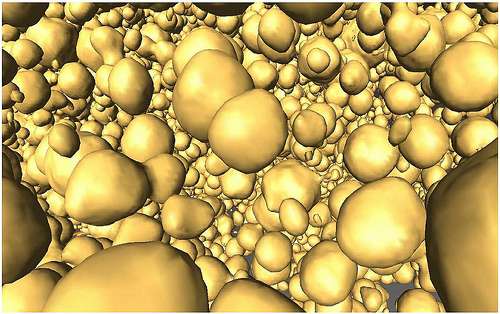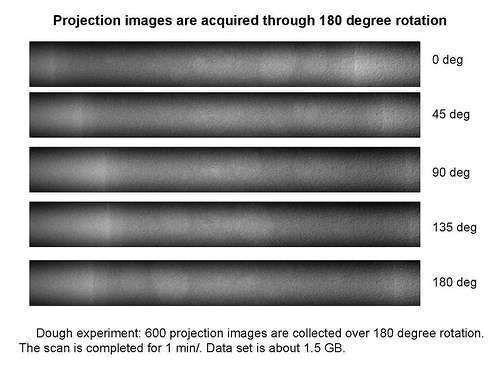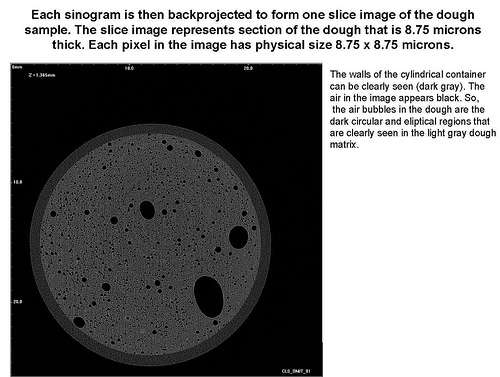University of Manitoba Food Scientist Martin Scanlon and PhD Candidate Filiz Koksel work with CLS scientists George Belev and Adam Webb to visualize the bubble formations in bread dough using powerful X-rays on the Biomedical Imaging and Therapy (BMIT) beamline. The research will help bakers create more consistent, healthy and gluten free loaves.
Baking the perfect loaf of bread is both a science and an art, so researchers are using Canada's only synchrotron to look at the way bubbles form in bread dough to understand what makes the perfect loaf and how gluten-free products might better resemble traditional bread.
Researchers from the University of Manitoba (U of M) alongside scientists at the Canadian Light Source (CLS) synchrotron used powerful X-rays on the Biomedical Imaging and Therapy (BMIT) beamline to look carefully at the fine details of dough.
This is the first time that scientists have been able to see the very small bubbles that form within bread dough during the mixing process.
Filiz Koksel, a PhD student at the U of M, said that studying the makeup of the bubbles will help bakers create more consistent loaves of bread.
"During the mixing process, bits of the dough flop over and trap air in the dough," said Koksel. "The air bubbles get smaller and smaller during mixing and they make up around 10 per cent of the volume of the dough – it's a significant ingredient."
The amount and the size of the bubbles in the dough changes based on the ingredients and the amount of mixing that takes place. Changes to either the mixing process or the ingredients can have drastic effects on the outcome of the dough.
University of Manitoba Food Scientist Martin Scanlon and PhD Candidate Filiz Koksel work with CLS scientists George Belev and Adam Webb to visualize the bubble formations in bread dough using powerful X-rays on the Biomedical Imaging and Therapy (BMIT) beamline. The research will help bakers create more consistent, healthy and gluten free loaves.
"For example, using less salt often results in more air that can ruin your dough, giving you bread with big keyholes," added Koksel.
Visualizing the structure of the dough is something BMIT scientist George Belev said was a unique experiment for him.
"The 3D visualization of the bubbles in the dough requires a very fast, high-resolution computed tomography (CT) experiment which is only possible with high-intensity synchrotron X-ray sources like the ones available on the Biomedical imaging and Therapy beamline at the CLS," said Belev. "We take 600 images in less than a minute as the sample rotates over 180 degrees to obtain a 3D image of the bubbles in the dough sample.
"By repeating the one-minute long CT scan, we can obtain important information about the bubble number, size, shape and volume, along with the evolution and changes to the bubble population over time as the dough ages."
University of Manitoba Food Scientist Martin Scanlon and PhD Candidate Filiz Koksel work with CLS scientists George Belev and Adam Webb to visualize the bubble formations in bread dough using powerful X-rays on the Biomedical Imaging and Therapy (BMIT) beamline. The research will help bakers create more consistent, healthy and gluten free loaves.
After processing the data, Belev said that one small sample of dough (about 83 mm3) contained over 24,000 tiny bubbles.
"The data clearly proves the air bubble population in the dough sample is very complex."
There are health benefits to the research as well that could allow bakers to cut back on the amount of salt (sodium) in the dough and still allow for a good crumb structure.
Koksel also hopes the results will translate into better crumb textures for gluten-free products.
"Gluten is great at holding onto gas. When you remove the gluten, there is difficulty with the gas holding properties of the dough, so our research will help us understand how to make better gluten-free products."
Provided by Canadian Light Source























